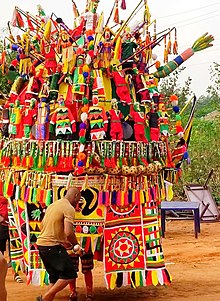Ijele masquerade is a famous and special masquerade in Anambra State and it stands tall as a symbol of grandeur and splendor. It is believed to be the king of all masquerades in the Eastern part of Nigeria.
This ancient and revered masquerade holds a special place in the hearts of the Igbo people, captivating audiences with its majestic presence and captivating performances. Rooted in centuries-old traditions, the Ijele masquerade represents the essence of Igbo culture, reflecting the beliefs, history, and spirituality of this vibrant ethnic group.
Based on the oral accounts, the origins of Ijele can be traced back to Umueri. It was the Umueri community that introduced the first “izi egwu ijele” (mask ceremony) to neighboring communities such as Aguleri, Nsugbe, Ogbunike, Nando, Awkuzu, and more. The Ijele masquerade is renowned for its remarkable size and elaborate design, often towering up to 15 feet in height. The Ijele mask holds the distinction of being the largest mask system in the history of global masking traditions. It consists of two distinct sections, namely the upper and lower segments, with a significant python serving as the dividing point at the center.
The Ijele masquerade is renowned for its remarkable size and elaborate design, often towering up to 15 feet in height. The Ijele mask holds the distinction of being the largest mask system in the history of global masking traditions. It consists of two distinct sections, namely the upper and lower segments, with a significant python serving as the dividing point at the center.
The upper section of Ijele is referred to as Mkpu Ijele, while the lower section is known as Akpakwuru Ijele or Ogbanibe. The central part is called Eke-Ogba, symbolizing the Python.
The masquerade is adorned with intricate and colorful costumes, featuring an array of feathers, beads, fabrics, and masks that represent different deities, historical figures, and ancestral spirits.
Grand celebrations such as harvest festivals, religious ceremonies, burial ceremonies, coronations, and other significant events in Southeastern Nigeria are often marked with the honourable presence of the Ijele masquerade. It performs in burial ceremonies of great and powerful kings, any member of the Ijele family, or at the death of the oldest man in the community. It also performs during the dry season to mark fertility and annual bountiful harvest.
To accommodate the substantial size of Ijele, an outdoor venue must be arranged wherever it is scheduled to perform. The preparation of Ijele costumes and the construction of its house require the dedicated efforts of approximately 100 men working for six months prior to the performance.
In the olden days, the Ijele masquerade used to have 45 different other masquerades performed on top of it. In recent civilizations, the 45 masquerades have been replaced by the 45 figurines seen on top of it.
As the pinnacle of all masquerades, Ijele performs solo and typically takes the final position in the masquerade procession. Ijele mask carriers, chosen by ballot, seclude themselves for three months, during which they live on a special diet to acquire the strength necessary to don the mask.
Read Also: Sociocultural Implications Of The Depiction Of The Eyo Masquerade In Gangs Of Lagos
Ijele is a family of 4 consisting of the mother, father, police, and palm wine taper. Nne Ijele meaning “Mother of Ijele” is a usually beautiful lady masquerade that holds a big ox tail with a carved enamel plate. It performs dances to flute and soft music. Ijele’s Father called “Onuku” has a big face and dresses in chieftaincy regalia.
Ijele Police are usually six. Their duty is to ensure that the spectators do not encroach on Ijele’s father or mother.
The Ijele is accompanied by the Ijele palm tapper for the sole purpose of picking its rear as it performs. Another significant personality is the Ijele fan carrier of Akupe carrier. It is not really a masquerade but it plays a crucial role in leading the Ijele with its symbolic powerful fan called Akupe. Once the Ijele loses sight of the fan and its carrier, it gets lost and it signifies danger. Ijele moves when the fan carrier moves and also stops when it stops.
Ijele mask carriers, chosen by ballot, seclude themselves for three months, during which they live on a special diet to acquire the strength necessary to don the mask.
Almost all the costumes worn by the masquerade have their unique symbolism. The python symbolizes royalty and the mightiness of Ijele. The trees, animals, white men, and carved human activities all signify the wholesomeness of Ijele as every aspect of human life is depicted in the Ijele masquerade. The mermaid objects signify Ijele as the greatest of all masquerades. The horse represents majesty and greatness.
Ododo is an expensive, colorful velvety material worn by the Ijele. It has many colours but black, yellow, and red are more pronounced.
During its performances, Ijele is accompanied by a unique band group that adds to the grandeur of the spectacle. This band, known as “Igba-eze” or the Royal Band group, plays a vital role in entertaining and enhancing the overall experience. The Igba-eze band also referred to as the “Akunechenyi” in Igbo language, which translates to “drums of the Kings,” showcases a variety of musical instruments that contribute to the enchanting atmosphere.
The band comprises several traditional musical instruments, including four drums, ogene (a metal gong), ubom (a wooden slit drum), uyo (a small drum), Ekwe (a wooden instrument), flute (known as Oja flute), and wooden clappers called aja-oja. Each instrument serves a distinct purpose, creating a harmonious blend of captivating rhythms and melodies.
The drums, with their deep and resonant beats, provide the foundation of the music, infusing it with powerful and rhythmic energy. The ogene, a large metal gong, adds a distinct metallic sound that cuts through the air, contributing to the overall intensity of the performance. The ubom, uyo, and Ekwe each have their unique tonal qualities, creating a rich and diverse sonic tapestry.
Accompanying the percussive instruments, the flute (Oja-ufele) lends a melodic aspect to the music, enchanting listeners with its soothing and lyrical notes. The wooden clappers (aja-oja) provide a rhythmic accent, adding texture and complexity to the overall sound.
When Ijele takes the stage, the Igba-eze band sets the tempo and rhythm, providing the musical backdrop for its captivating performances. The synchronized movements of the masquerade and the rhythmic patterns of the band create a mesmerizing synergy, captivating the audience and bringing the traditions and cultural heritage of the Igbo people to life.


